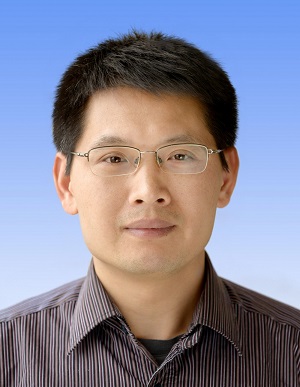
Yihua Huang, Ph.D, Prof.
-
Principal Investigator
State Key Laboratory of Biomacromolecules, IBP
Research Interests: Structural and functional studies of (1) Membrane protein biogenesis and various protein-conducting channels; (2) Biological membrane biogenesis.
Email: yihuahuang@ibp.ac.cn
Tel: 010-64888789
Address: 15 Datun Road, Chaoyang District, Beijing, 100101, China
Chinese personal homepage
- Biography
1990 - 1995 Peking University, China, B.Sc. in Physiology and Biophysics
1995 - 1998 Peking University, China, M.Sc. in Physiology
1998 - 2004 Graduate Student, Department of Biochemistry, Weill Medical College of Cornell University, USA
2004 - 2010 Postdoctoral Associate, Department of Biochemistry/HHMI, UT Southwestern Medical Center at Dallas, USA
2011 - Investigator, Institute of Biophysics, Chinese Academy of Sciences
- Awards
- Membership in Academies & Societies
- Research Interests
The main research focus of our group is on structural and functional studies of (1) membrane protein biogenesis and various protein-conducting channels; (2) biological membrane biogenesis.
1. Membrane protein biogenesis and protein-conducting channels
Gram-negative bacteria, mitochondria and chloroplast are surrounded by two lipid bilayers: the inner membrane and the OM. The inner membrane harbours predominantly α-helical proteins, whereas the OM contains primarily β-barrel fold proteins. For more than 40 years, researchers have been fascinated by the question of how proteins are transported across or are integrated into membranes and of how different types of membrane proteins fold in the membranes. Genetic experiments identified components that are required for secretory protein translocation across and nascent membrane protein polypeptide chain integration into lipid bilayers. These achievements set the stage for investigations into the molecular mechanism of membrane protein biogenesis and protein translocation. Our group focuses on structural studies of those evolutionarily conserved membrane proteins or membrane protein complexes (mainly protein-conducting channels) responsible for membrane protein integration and protein translocation across membranes.
2. Biological membrane biogenesis
The cell membrane is a thin semi-permeable membrane that surrounds the cytoplasm of a cell, enclosing its contents. Its function is to protect the integrity of the interior of the cell by allowing certain substances into the cell, while keeping other substances out. The membrane of Gram-negative bacteria, for example, is primarily composed of a mix of membrane proteins, lipoproteins, LPS and phospholipids. Our group is interested in the structure and function of proteins that participate in the synthesis, transport and assembly of individual components of bacterial cell membranes to understand membrane biogenesis in general.
- Grants
- Selected Publications
1. Yanlong Xin, Yan Zhao, Jiangge Zheng, Haizhen Zhou, XuejunCai Zhang, Changlin Tian(*), and Yihua Huang*.(2017)Structure of YidC from Thermotogamaritima and its implications forYidC-mediated membrane protein insertion . FASEB J. Accepted.
2. Qingshan Luo , Xu Yang , Shan Yu , Huigang Shi , Kun Wang , Le Xiao , Guangyu Zhu , Chuanqi Sun ,Tingting Li , Dianfan Li , Xinzheng Zhang , Min Zhou &Yihua Huang*.(2017)Structural basis for lipopolysaccharide extractioby ABC transporter LptB2FG. Nat StructMol Biol. May;24(5):469-74
3. Han L, Zheng J, Wang Y, Yang X, Liu Y, Sun C, Cao B, Zhou H, Ni D, Lou J, Zhao Y, Huang Y*. (2016)Structure of the BAM complex and its implications for biogenesis of outer-membrane proteins. Nat Struct Mol Biol. Mar; 23(3):192-6
4. Yan Wang, Archana AndolePannuri, Dongchun Ni, Haizhen Zhou, Xiou Cao, Xiaomei Lu, Tony Romeo & Yihua Huang. (2016) Structural basis for translocation of a biofilm-supporting exopolysaccharide across the bacterial outer membrane. J. Biol. Chem 291(19):10046-57
5. Ni D, Huang Y*. (2015)The Expression, Purification, and Structure Determination of BamA from E. coli. Methods Mol Biol. 1329:169-78.
6. Shuai Qiao., Qingshan Luo., Yan Zhao., Xuejun Cai Zhang. & Yihua Huang. (2014) Structural basis for lipopolysaccharide insertion in the bacterial outer membrane. Nature, 511(7507):108–111.
7. Baohua Cao.,Yan Zhao.,Yongjun Kou.,Dongchun Ni.,Xuejun Cai Zhang. & Yihua Huang. (2014) Structure of the nonameric bacterial amyloidsecretionchannel. PNAS, 111(50):E5439-44.
8. Dongchun Ni.,Yan Wang.,Xu Yang., Haizhen Zhou.,Xiaomin Hou.,Baohua Cao.,Zhixin Lu., Xinsheng Zhao., Kun Yang. & Yihua Huang.(2014) Structural and functional analysis of the β-barrel domain of BamA from Escherichia coli. The FASEB Journal, 28(6):2677-85.
9. Huang Y., Smith B.,Chen L.,Baxter R.& Deisenhofer J.(2009) Insights into pilus assembly and secretion from the structure and functional characterization of usher PapC. PNAS, 106(18):7403-7.
10. Huang Y., Baxter R., Smith B.S., Partch C.L., Colbert C.L.& Deisenhofer J.(2006) Crystal structure of cryptochrome 3 from Arabidopsis thaliana and its implication for photolyase activity. PNAS, 103(47):17701-6.
11. Huang Y., Lu M.& Wu H.(2004) Antagonizing XIAP-mediated caspase-3 inhibition: Achilles' heel of cancers? Cancer Cell. 5(1):1-2
12. Huang Y., Rich R., Myszkat D.& Wu H.(2003) Requirement of both the second and third BIR domains for the relief of X-linked inhibitor of apoptosis protein (XIAP)-mediated caspase inhibition by Smac. J. Biol. Chem. 278(49):49517-22
13. Huang Y., Park Y.C., Rich R.L., Segal D., Myszka D. G.& Wu H.(2001) Structural basis of caspase inhibition by XIAP: differential roles of the linker versus the BIR domain. Cell, 104:781-790.
(From Yihua Huang, February 6, 2018)

